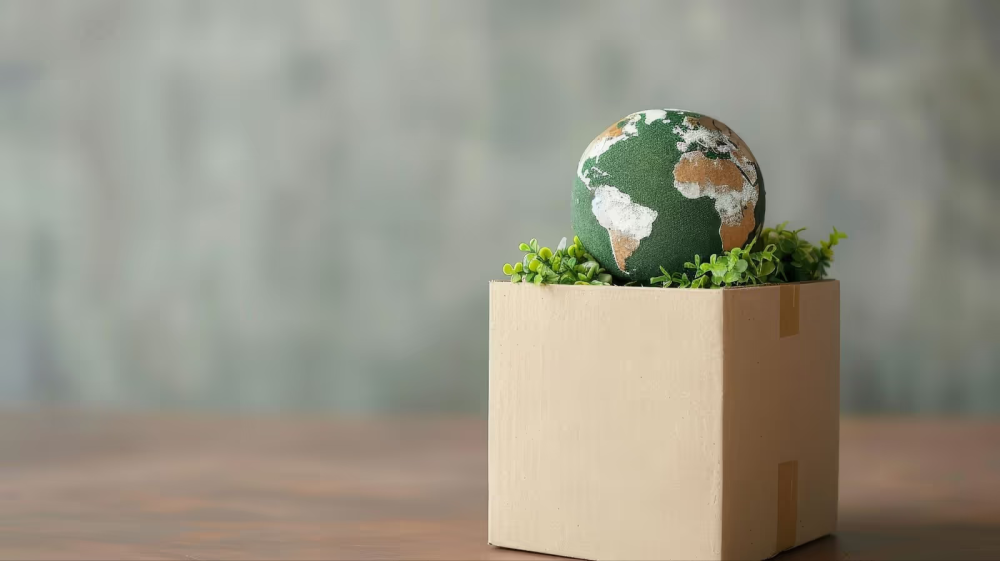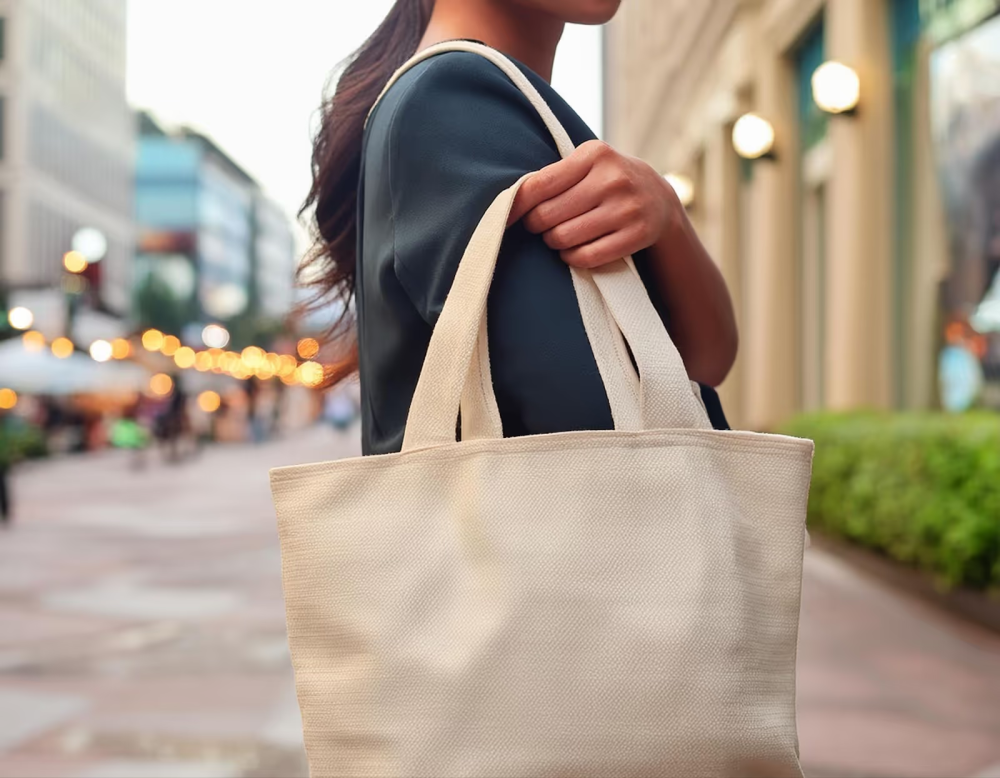Learn more about eco-friendly packaging options and why they're better as a long-term packaging solution.
More and more consumers are making purchasing decisions based on a company's commitment to sustainability. Cardboard boxes overflowing with plastic peanuts and mountains of unrecyclable labels — these traditional packaging practices are no longer cutting it.


The environmental impact of packaging waste is undeniable. At this point, it's a concern both businesses and their customers share.
The good news? There's a solution.
Eco-friendly packaging offers a win-win scenario. This innovative approach allows your business to reduce its environmental footprint while enhancing brand image and potentially even boosting your bottom line.
This blog post is your one-stop guide to understanding eco-friendly packaging options, the benefits they offer your business, and how to implement them seamlessly.
The Benefits of Eco-Friendly Packaging for Your Business
It's not just about saving the environment — though that's the biggest reason everyone should shift to eco-friendly packaging.
For businesses, the use of eco-friendly packaging can have a direct impact on their success. Here are a few ways it does so.
Enhanced Brand Image
According to theroundup.org, 78% of consumers value sustainability, and 55% are willing to pay more for eco-friendly brands. Being a more sustainable brand is not just good business; it's what your customers expect. Here are ways being more eco-conscious elevates your brand.
- Alignment with Customer Values — Millennials and Gen Z prioritize sustainability. Eco-friendly packaging demonstrates your company shares their values. This fosters trust and loyalty.
- Positive Brand Perception — Consumers perceive companies using sustainable practices as responsible and forward-thinking. This builds a positive brand image and differentiates you from competitors.
- Storytelling and Marketing Opportunities — Use clear labeling or packaging design to showcase your commitment to sustainability. Share your story on social media, press releases, or your website to generate positive buzz and attract environmentally conscious customers.
- Increased Brand Advocacy — Customers who appreciate your sustainable efforts are more likely to become brand advocates. They may recommend your products to others or leave positive reviews, further strengthening your brand image.


You can open more doors to unique marketing campaigns as an environmentally conscious business.
- Partner with Environmental Organizations — Collaborate with environmental groups for joint promotions or educational initiatives.
- Transparency and Traceability — Showcase the sustainable sourcing of your packaging materials to add a layer of trust and transparency to your brand story.
- Interactive Campaigns — Encourage customer participation by offering rewards for returning or recycling their packaging.
By embracing eco-friendly packaging, you're not just doing good for the planet — you're creating a powerful marketing tool that resonates with today's environmentally conscious consumers.
Reduced Packaging Costs
While the initial switch to eco-friendly packaging might seem like an added expense, there are several ways it can lead to cost savings for your business.
Eco-friendly materials like recycled cardboard or mushroom mycelium are often lighter than traditional options. This translates to significant reductions in shipping costs, especially for businesses that ship a large volume of products.


In addition, eco-friendly packaging uses the least amount of material necessary to protect your product. This can lead to cost savings on packaging materials themselves, especially when combined with right-sized boxes.
Traditional packaging often requires complex sorting and disposal processes. Eco-friendly options like biodegradable or compostable materials could simplify waste disposal and potentially reduce waste management fees.
Improved Supply Chain Efficiency
Eco-friendly packaging also leads to a more efficient supply chain for your business.
Lighter eco-friendly packaging materials can significantly decrease the weight of your shipments. This translates to lower transportation costs. It also produces space-efficient packaging which optimizes storage space in your warehouse.
Understanding Eco-Friendly Packaging Options
The world of sustainable packaging offers various options, each with unique properties and environmental benefits. Here are some popular sustainable materials to help in finding the perfect fit for your brand and products.
Materials
When it comes to eco-friendly packaging, your choice of packaging products plays a crucial role. Here's a breakdown of some popular options.
Recycled Packaging


- Recycled Cardboard Boxes — The most ubiquitous eco-friendly option, these boxes are made from post-consumer or pre-consumer recycled content.
- Recycled Paperboard Envelopes — Similar to cardboard boxes, paperboard envelopes made from recycled content offer a sustainable alternative for lightweight products.
- Recycled Plastic Bags or Pouches — Made from recycled plastic materials, these can be a good option for specific products if the plastic itself is recyclable.
Biodegradable and Compostable Packaging


- Plant-Based Packaging — This category encompasses a variety of options like mushroom mycelium (fungus root structure), cornstarch-based materials, or even packaging made from seaweed. These materials break down naturally after disposal, minimizing environmental impact.
- Biodegradable Packing Peanuts — Made from materials like starch or cellulose, these offer a sustainable alternative to traditional plastic packing peanuts.
- Compostable Mailers — These mailers are typically made from plant-based materials. They're designed to break down in commercial composting facilities.
Reusable Packaging


- Refillable Containers — Ideal for products like cosmetics or cleaning solutions, refillable containers allow customers to reuse the container and purchase refills, reducing overall waste.
- Cloth Bags — Reusable cloth bags are a popular alternative to plastic shopping bags, promoting sustainability and potentially enhancing brand image.
- Reusable Shipping Envelopes — Made from durable materials like canvas, these envelopes can be used for multiple shipments, reducing waste associated with disposable mailers.
Another option is using water-activated tapes. These paper-based tapes replace plastic packing tape and activate with water, eliminating the need for plastic dispensers.
By exploring these eco-friendly options, businesses can reduce their environmental footprint and potentially appeal to customers who value sustainability.
Choosing the Right Material
Selecting the best eco-friendly material for your business depends on several factors.
- Product Characteristics — Fragile items may require sturdier materials, while lightweight products can benefit from minimized packaging.
- Cost and Availability — Balance eco-friendliness with budgetary constraints and material availability in your region.
- Disposal Options — Consider the composting capabilities in your target market if using biodegradable options.
- Brand Image — Choose materials that align with your brand's sustainability message and customer expectations.
By understanding the benefits and limitations of each eco-friendly material, you can make informed decisions that contribute to a greener supply chain and a positive brand image.
Minimization
As a small business owner, you understand the importance of both protecting your products and keeping costs down. Here's where the concept of "minimizing packaging" comes in. It's about finding the sweet spot between using just enough material to ensure your product arrives safely and avoiding unnecessary bulk.


This translates to benefits for you and your customers:
- Reduced Costs — Less packaging means less material to buy, store, and ship. It can also lead to lower shipping costs, especially with weight-based pricing.
- Environmental Impact — It might not seem like much but by minimizing packaging, you contribute to a smaller ecological footprint. This resonates with eco-conscious customers who appreciate sustainable practices.
- Customer Satisfaction — A perfectly sized package creates a more streamlined unboxing experience.
Here are some design strategies you can implement to achieve this balance:
- Rightsizing Boxes — One of the biggest culprits of wasted space is oversized boxes. Accurately measure your products and choose boxes that provide a snug fit with minimal extra room. Consider using adjustable or custom-sized boxes for a perfect match.
- Minimal Inserts — Ditch the excessive packing peanuts and bubble wrap! Explore alternative cushioning materials like inflatable air pillows or wrapping paper. These options are often lighter and more space-efficient while still offering adequate protection.
- Form-Fitting Packaging — For specific items, consider using shaped cardboard inserts or molded plastic trays that cradle the product. This minimizes movement and eliminates the need for loose fill.
Remember, minimizing packaging doesn't have to mean sacrificing aesthetics. You can still create a visually appealing and informative package using recycled or compostable materials.
Conclusion
Eco-friendly packaging isn't just good for the planet — it's a smart business decision. It strengthens your brand image with eco-conscious consumers, potentially reduces costs through lighter materials and efficient shipping, and streamlines your supply chain.
By exploring material options, minimizing packaging, and choosing the right fit for your products, you can create a sustainable future for your business and the environment. Remember, a small change in packaging can make a big difference.
And if you'd like to learn more about eco-friendly packaging, talk or chat with one of PackM's sales representatives. They'll help you pick the right one for your business. You can also email us at hello@packm.com
Related Posts:







